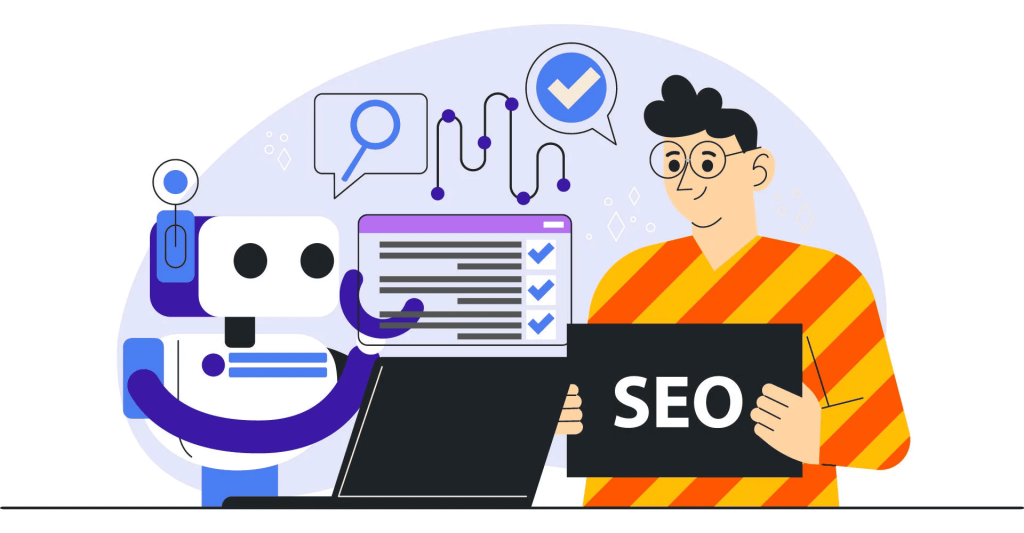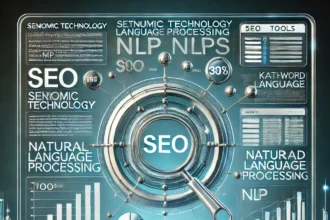The promises sound too good to be true. “I cranked out 1,000 SEO-optimized pages in 24 hours.” “My AI built a complete content silo while I slept.”
Yet here you are, staring at your content calendar, wondering: Can I actually scale this fast without destroying my rankings?
Here’s what 10+ years in SEO have taught me: scaling content production is absolutely possible in 2025. The trap? Chasing volume while quality crumbles beneath you. When content loses its value, search engines don’t just ignore it—they actively penalize it.
The reality is nuanced. AI can dramatically accelerate certain parts of your SEO workflow, but other elements still demand human expertise and judgment.
In this guide, I’ll show you exactly where AI can safely 10x your content production and the critical touchpoints where human oversight remains absolutely essential.
What “Quality Content” Means in the Age of AI-Driven SEO
Quality still wins in search—that hasn’t changed. As Gartner predicts, even in the age of AI-generated content, utility and quality remain the most important factors for winning in organic search.
Google’s quality standards aren’t suggestions anymore—they’re non-negotiable requirements that determine whether your content ranks, drops, or disappears entirely.
The search landscape has fundamentally shifted. Shallow rewrites, templated content, and faceless bylines that once drove traffic are now actively penalized. Here’s what Google actually rewards in 2025:
1. E-E-A-T Has Become the Minimum Standard
Experience, Expertise, Authoritativeness, and Trust aren’t nice-to-haves—they’re active ranking factors. Google’s algorithms now scan for real credibility signals: original screenshots, detailed contributor bios, expert quotes, and properly cited sources. Content without these elements gets filtered out before it even has a chance to compete.
2. The Helpful Content System Evaluates Your Entire Site
Since the March 2024 Helpful Content Update, Google judges sites holistically, not just individual pages. One weak content section can now drag down your entire domain’s search performance.
3. Freshness and Depth Are Non-Negotiable
Surface-level answers and outdated examples get buried—even if they’re technically accurate. What ranks consistently: current references, actionable detail, unique perspectives backed by data, and proper technical implementation including schema markup.
Some teams have already hit this balance. Gushwork services drove a 1,200% increase in search impressions over six months, while meeting modern SEO standards and maintaining editorial quality.
The challenge isn’t knowing what Google wants—it’s delivering these standards consistently while scaling your content production. That’s exactly where strategic AI implementation makes the difference.
SEO Tasks That AI Can Handle (And Scale) Right Now
Here’s the hard truth: most content teams don’t struggle with creativity—they drown in process. You have brilliant writers and sharp editors, but they’re spending 60% of their time on tasks that could be automated.
After working with dozens of SEO teams, I’ve identified four critical bottlenecks that kill content velocity. More importantly, these are the exact areas where AI can deliver immediate, measurable results without compromising the quality that Google rewards:
1. Research Takes Too Long
Your team spends entire days clustering keywords, mapping search intent, analyzing SERPs, and hunting for content gaps. What should take hours stretches into weeks.
AI transforms this completely. It can process hundreds of keywords, group them by intent, identify SERP patterns, and surface competitor angles in minutes, not days.
Real example: Instead of manually sorting 200 keywords by search intent, AI can categorize them by funnel stage and opportunity level instantly, giving your strategist a head start rather than a headache.
2. Content Brief Creation Doesn’t Scale
Your writers need direction—clear goals, structure, tone guidelines, and strategic linking opportunities. But creating detailed briefs for 50+ pieces per month? That’s a full-time role in itself.
AI can auto-generate comprehensive briefs by analyzing top-ranking pages, extracting common H2 structures, and identifying key topics to cover. Your content strategist then adds brand voice and strategic direction—the human elements that actually matter.
3. Editorial Review Bandwidth Hits a Wall
Skilled editors elevate voice, improve flow, strengthen trust signals, and ensure SEO compliance. However, they can’t edit every paragraph in 100+ monthly pieces without burning out.
AI can pre-edit for formatting consistency, tone alignment, heading structure, and keyword optimization. This means your human editors can focus on high-value work, such as storytelling, brand voice, and strategic messaging.
4. Publishing and Optimization Tasks Create Delays
You’ve got polished content, but now you need meta descriptions, alt text, internal links, schema markup, and CMS formatting. Multiply this by 30 posts, and your publishing pipeline grinds to a halt.
This is where AI shines brightest. It can suggest relevant internal links, generate metadata, flag missing schema opportunities, and even format content for your CMS—all before human review.
The bottom line: AI isn’t replacing your content team—it’s removing the 40% of tasks that prevent them from doing their best work.
Where AI Fits—and Where It Still Fails
“AI is the steam engine of the mind,” says Reid Hoffman—the engine that drove the industrial revolution to its peak. In SEO, that means you now have the power to accelerate content production like never before.
But here’s what most teams miss: a powerful engine still needs an experienced driver. You can’t just floor the accelerator and expect to reach your destination safely.
After implementing AI workflows across dozens of content teams, I’ve mapped the exact territories where this engine performs flawlessly, and the critical areas where human oversight remains non-negotiable.
Full Speed Ahead: Where AI Excels
These tasks are perfect for AI automation—high-volume, pattern-based work that used to drain your team’s time:
- Research and analysis: Keyword clustering, SERP pattern identification, and competitive gap analysis
- Content scaffolding: Structural outlines, heading hierarchies, and topic flow
- Technical optimization: Metadata generation, NLP scoring, and internal link suggestions
- Publishing logistics: Formatting, CMS preparation, and schema markup
Proceed with Caution: Where Humans Must Drive
These areas require judgment, strategy, and brand expertise that AI can’t replicate:
- Strategic validation: Confirming search intent alignment and ranking opportunity
- Brand control: Brief strategy, voice consistency, and messaging alignment
- Quality assurance: Tone refinement, clarity checks, and factual accuracy verification
- Final oversight: Editorial sign-off, originality validation, and publish decisions
AI is the engine. It moves faster than human teams ever could. But you still drive.
What Over-Automation Looks Like
AI can increase output, but if you remove human oversight, quality collapses. These are the signals that your SEO workflow is relying too heavily on automation.
1. Every page reads the same
- Generic intros and reused structures
- Repetitive phrasing across different topics
- No brand voice, no distinct perspective
2. Rankings look fine, but engagement craters
- Time-on-page drops below 30 seconds
- Bounce rates jump site-wide.
- Scroll depth and internal clicks disappear
3. Entire content sections lose visibility
- Pages are removed from the index after quality updates
- Low-value content triggers sitewide suppression
- Even strong content can get pulled down by proximity
AI can extend your reach, but without human oversight, it lowers your ceiling. The goal isn’t just to produce more content—it’s to produce content that actually moves the needle.
Checklist: How to Scale Without Losing SEO Quality
Use this checklist to pressure-test your AI-enabled SEO workflow. If you’re skipping any of these steps, you’re scaling risk—not just content.
1. Editorial Guardrails
- Train AI tools on your brand voice and tone rules
- Add 2–3 unique insights or examples per article
- Block auto-publishing—nothing goes live without human review
2. Strategic Controls
- Set thresholds for search intent validation before content creation
- Maintain clear boundaries between AI-drafted and human-led sections
- Prioritize topical depth over keyword count
3. Quality Assurance
- Run originality and plagiarism checks on every draft
- Add links to real sources, not AI-generated citations
- Verify that internal linking supports site architecture and conversion paths
Treat this checklist as your SEO seatbelt: invisible when it’s working—but painful to ignore when you crash.
Final Thought: Scale Smart, Not Blind
The AI revolution in content creation is just beginning. Tools will get faster, content demand will keep climbing, and the temptation to maximize output will only grow stronger.
But here’s what a decade in SEO has taught me: the teams that dominate search results aren’t the ones producing the most content—they’re the ones who scale with surgical precision.
They know exactly where AI can accelerate their workflow and where human expertise remains irreplaceable. They treat quality as a competitive advantage, not a bottleneck to overcome.
The choice is yours: chase volume and risk everything, or build a content engine that scales sustainably while protecting the trust signals that keep you visible in search.
If you’re ready to build that kind of system, Gushwork services can help you automate your SEO execution, without sacrificing the quality signals that drive real results.

















